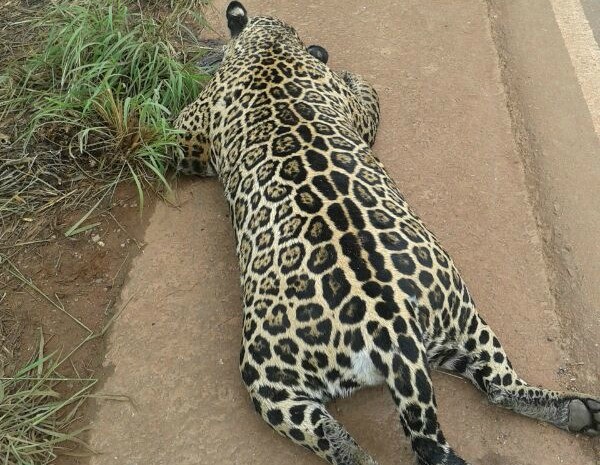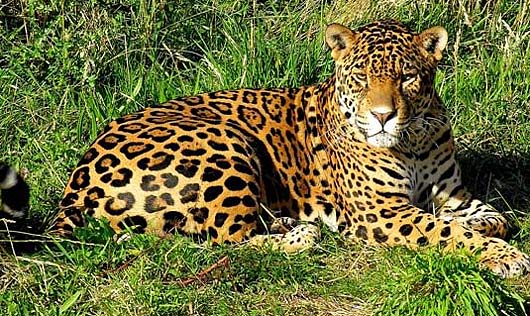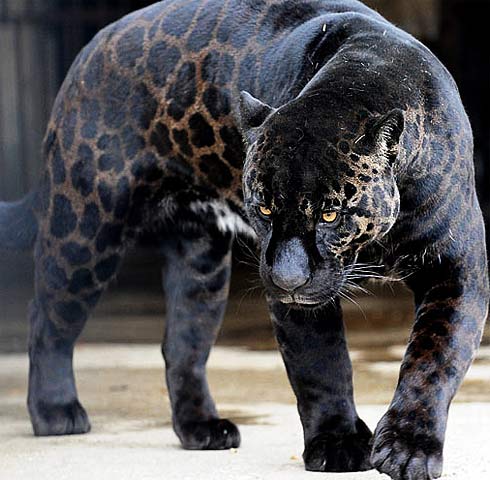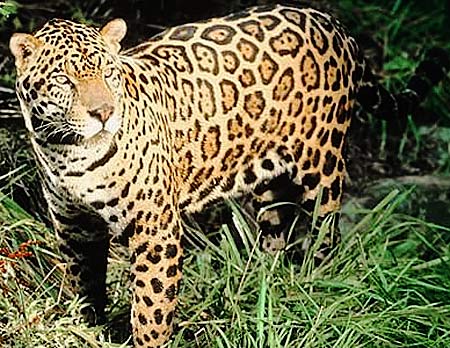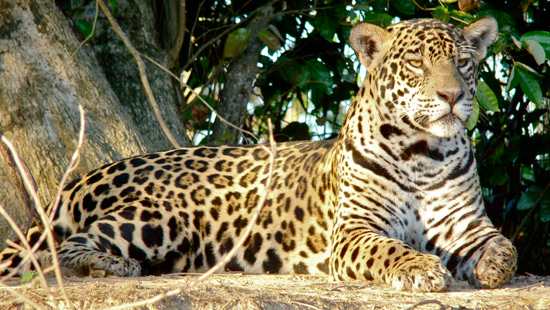 Zelden wordt jaguar geëxporteerd uit land waar dier zijn habitat heeft
Zelden wordt jaguar geëxporteerd uit land waar dier zijn habitat heeft30-05-2014 Door: © Paul Kraaijer (voor Obsession Magazine)
Paramaribo -Tussen 2010 en 2014 zijn wereldwijd jaarlijks enkele tientallen jaguars legaal verhandeld, vooral tussen dierentuinen onderling. Daarnaast blijken zelfs exemplaren te zijn geëxporteerd met als eindbestemming een circus…. Dat blijkt uit de handelsdatabase van CITES (Convention on International Trade in Endangered Species of Wild Fauna and Flora). Uit die database blijkt ook dat een Surinaamse jaguar in 2012 in een dierentuin in Turkije belandde. Een opmerkelijke export. Een export waarover betrokken instanties en de mogelijk ontvangende dierentuin in Turkije het zwijgen toe doen.
- Guatemala (dat in 2011 twee jaguars exporteerde naar Honduras),
- Colombia*,
- Mexico (in 2011 exporteerde dit land drie jaguars naar de Dominicaanse Republiek en in 2010 werden al twee jaguars naar de Dominicaanse Republiek vervoerd, alleen voor een dierentuin, een exemplaar werd geëxporteerd naar Guatemala en een naar Panama, er werd zelfs een jaguar uit de VS geimporteerd in 2010),
- Panama en
- Suriname.
* Het is opmerkelijk, dat Colombia in 2011 een jaguar importeerde uit Frankrijk (met als bestemming een dierentuin) terwijl het Zuid-Amerikaanse land in 2010 een jaguar exporteerde naar Chili en in hetzelfde jaar twee exemplaren importeerde uit Frankrijk voor een dierentuin.
 |
| De staartloze jaguar in de Paramaribo Zoo. (Bron foto: eigen foto Kraaijer) |
Suriname heeft tussen 1975 (het jaar dat CITES startte met haar handelsdatabase) en 2014 slechts eenmaal een jaguar geëxporteerd en dat was vrij recent, in 2012, naar een dierentuin in Turkije. Het blijkt echter bijzonder lastig om te achterhalen door wie of wat de jaguar in 2012 werd geëxporteerd uit Suriname en wat de eindbestemming was, welke Turkse dierentuin. Dat land heeft feitelijk twee grote dierentuinen waar ook jaguars worden gehouden, te weten de Ankara Zoo in Ankara en de Gaziantep Zoo in Gaziantep. De dierentuin in de stad Gaziantep zou de vierde grootste dierentuin ter wereld zijn met zo’n 4.000 dieren verdeeld over 270 soorten.
Beide dierentuinen reageerden niet op herhaalde verzoeken om te antwoorden op de vraag of zij wellicht een jaguar uit Suriname in 2012 hebben ontvangen.
Bij de export betrokken instanties in Suriname waren eveneens niet bereikbaar voor een reactie, ondanks herhaalde verzoeken, zoals de twee officiële contacten van CITES in Suriname te weten het hoofd van de dienst ‘s Lands Bosbeheer (‘Management Authority’) en de zogenoemde Natuurbeschermingscommissie binnen de dienst ‘s Lands Bosbeheer (‘Scientific Authority’).
Ook de Douane Suriname hult zich in stilzwijgen.
Kennelijk wil of kan geen van genoemde instanties de vragen beantwoorden wie of wat de jaguar in 2012 heeft geëxporteerd en naar welke dierentuin in Turkije.
De export is opmerkelijk, omdat Suriname hiermee een van de weinige landen is waar de jaguar in het wild leeft en dat een exemplaar de laatste jaren heeft geëxporteerd. De vraag kan gesteld worden, waarom die ene Surinaamse jaguar bijvoorbeeld niet terecht is gekomen in de lokale Paramaribo Zoo. Daar bevindt zich immers slechts een jaguar en die mist nota bene zijn staart….
Hieronder ter informatie een overzicht uit de jaren 2013, 2012, 2011 en 2010 van de wereldwijde handel, export, in jaguars.
2013
In dat jaar is er sprake van slechts vier verhandelde, geëxporteerde, jaguars. Belarus importeerde twee jaguars uit Georgië voor een dierentuin. Ook werd een exemplaar geïmporteerd uit Rusland en een uit de Ukraine, beide bestemd voor een circus…..! Volgens CITES kwamen de vier door Belarus geïmporteerde jaguars oorspronkelijk ook uit Belarus….. Dus via een omweg (Georgië, Rusland en Ukraine) keerden de vier jaguars weer terug in hun oorspronkelijke land van herkomst, Belarus.
2012
Eenentwintig jaguars werden in totaal in 2012 door diverse landen geëxporteerd. In geen van die landen komt het dier in het wild voor. Opvallend is, dat enkele landen een jaguar blijken te hebben geëxporteerd om vervolgens een exemplaar te importeren:
België importeerde drie jaguars uit Griekenland en de handelsdatabase van CITES vermeldt als doel van de export, commerciële doeleinden.
De Verenigde Arabische Emiraten importeerde drie jaguars uit België (!) met als bestemming ‘privé’ (zouden dat de door België uit Griekenland geïmporteerde dieren zijn geweest?), twee jaguars uit Spanje ook met als doel ‘privé’ en een ander exemplaar uit Spanje voor zogenoemde commerciële doeleinden.
Azerbeidzjan importeerde een jaguar uit Letland (oorspronkelijke herkomst Rusland) voor een circus. Het Baku Staats Circus van dat land blijkt inderdaad jaguars in haar show te hebben.
Belarus liet twee jaguars uit Rusland importeren voor een dierentuin.
Japan importeerde een jaguar uit Polen met als eindbestemming een dierentuin.
Letland importeerde een exemplaar uit Rusland voor een circus (let wel, Letland exporteerde in hetzelfde jaar een jaguar naar Azerbijan…..).
Saoedi Arabië importeerde in 2012 twee jaguars respectievelijk uit Frankrijk en Griekenland en beide hadden als bestemming een dierentuin.
Thailand importeerde een jaguar uit Zuid-Afrika, voor een dierentuin, terwijl laatst genoemd land een jaguar importeerde uit Zambia, terwijl dat dier oorspronkelijk afkomstig was uit Frankrijk, met als doel educatie.
Turkije importeerde een jaguar uit Suriname, ook voor een dierentuin. Suriname was het enige land in 2012, en sowieso de laatste jaren een van de weinige landen, waar de jaguar in het wild voorkomt dat een exemplaar exporteerde.
2011
Dit jaar werden in totaal drieëndertig jaguars wereldwijd verhandeld onder CITES-regelgeving:
China importeerde twee jaguars uit Spanje, bestemd voor een dierentuin.
Colombia, een land waar de jaguar zijn habitat heeft, importeerde een exemplaar uit Frankrijk, dat oorspronkelijk afkomstig was uit Spanje, voor een dierentuin.
De Dominicaanse Republiek importeerde drie jaguars uit Mexico voor een dierentuin.
Hongkong importeerde een jaguar uit Zuid-Afrika voor een fokprogramma.
Honduras importeerde in 2011 twee exemplaren uit Guatemala met als doel wetenschap. In beide landen leeft de jaguar in het wild.
Indonesië haalde drie jaguars uit het buitenland waarvan twee uit Duitsland en een uit de Tsjechische Republiek, allen met als bestemming een dierentuin. De jaguar uit de Tsjechische Republiek kwam overigens oorspronkelijk uit Hongarije.
Japan importeerde twee jaguars voor een dierentuin uit respectievelijk Canada en China.
Kazachstan importeerde twee exemplaren uit respectievelijk Kirgizië en Rusland voor een circus.
Thailand importeerde twee jaguars uit Zuid-Afrika voor een dierentuin, terwijl Zuid-Afrika in 2012 maar liefst vijftien exemplaren importeerde waarvan twee uit de Verenigde Arabische Emiraten voor een ‘fokprogramma’, twee uit België (met als oorspronkelijk land van herkomst Duitsland) voor commerciële doeleinden en twee uit België voor een dierentuin, een exemplaar uit Frankrijk voor educatie, acht dieren uit Mexico waarvan vier voor een fokprogramma en vier voor een dierentuin.
2010
Zesendertig jaguars verruilden de ene internationale bestemming voor de andere internationale bestemming in 2010:
De Verenigde Arabische Emiraten importeerde twee exemplaren waarvan een uit Duitsland (voor een fokprogramma) en een uit Marokko met als bestemming een dierentuin. Het importerende land, Verenigde Arabische Emiraten, exporteerde in hetzelfde jaar een jaguar voor een fokprogramma naar Armenië.
Colombia exporteerde een jaguar naar Chili voor een dierentuin en importeerde twee exemplaren, voor een dierentuin, uit Frankrijk, terwijl een van die twee dieren van oorsprong afkomstig was uit Spanje.
De Dominicaanse Republiek importeerde twee jaguars uit Mexico bestemd voor een dierentuin.
Guatemala importeerde eveneens uit Mexico een jaguar voor een fokprogramma’.
Honduras importeerde zeven jaguars uit El Salvador (de handelsdatabase van CITES vermeldt hierbij niet het doel van de export).
Twee jaguars werden door Indonesië geïmporteerd uit respectievelijk de Tsjechische Republiek (de jaguar kwam oorspronkelijk uit Hongarije) en Rusland, beide voor een dierentuin.
Japan importeerde een jaguar uit Canada, voor een dierentuin.
Mexico importeerde een jaguar voor een dierentuin uit de VS, terwijl het dier oorspronkelijk uit Mexico afkomstig was……
Panama liet een jaguar overkomen uit Mexico voor een dierentuin.
Thailand importeerde vier exemplaren voor een dierentuin, waarvan twee uit Canada en een uit Namibië, terwijl de jaguar uit Namibië oorspronkelijk uit Zuid-Afrika kwam.
Turkije importeerde twee jaguars uit Frankrijk waarvan een voor een dierentuin en een voor commerciële doeleinden.
Trinidad & Tobago importeerde uit de VS, voor een dierentuin, drie jaguars.
Zuid-Afrika importeerde in 2010 vier jaguars, waarvan twee uit Belgie (voor commerciële doeleinden – dit dier heeft als origine Frankrijk – en een dierentuin), een uit de Tsjechische Republiek (voor een fokprogramma) en een uit Frankrijk voor educatieve doeleinden.
Suriname uitzondering: export van in het wild gevangen jaguar
Uit het voren gaande moge blijken dat er toch een aanzienlijke internationale handel in de bedreigde jaguar is en dat veel van die handel plaatsvindt tussen dierentuinen onderling. Maar, opmerkelijk zijn ook de paar exporten van jaguars die als eindbestemming een circus hadden… Kennelijk valt er veel geld te verdienen aan deze handel. Dat blijkt ook uit het feit, dat er landen zijn die in een jaar tijd zowel een jaguar importeren als exporteren……
Uit de CITES handelsdatabase wordt ook duidelijk dat er nauwelijks wordt gehandeld in in het wild gevangen exemplaren en dat Suriname de afgelopen negenendertig jaren slechts eenmaal, legaal, een panthera onca ofwel een ‘tigri’, zoals de jaguar in Suriname veelal wordt genoemd, heeft geëxporteerd. De zwijgzaamheid van alle bij die export betrokken instanties is overigens opmerkelijk…… Wat mag de Surinaamse burger niet weten over deze export?


